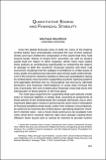Artículo
Quantitative easing and financial stability
Date
2016Abstract
Since the global financial crisis of 2008–09 many of the leading central banks have dramatically increased the size of their balance sheets and have shifted the composition of the assets that they hold toward larger shares of longer-term securities (as well as toward assets that are riskier in other respects). While many have hailed these policies as contributing significantly to containing the degree of damage to both the countries’ financial systems and their real economies resulting from the collapse of confidence in certain types of risky assets the policies have also been and remain quite controversial. One of the concerns raised by skeptics is that such quantitative easing by central banks may have been supporting countries’ banking systems and aggregate demand only by encouraging risk-taking by ultimate borrowers and financial intermediaries in areas that increase the risk of precisely the sort of destructive financial crisis that led to the introduction of these policies in the first place.
Collections
View/


